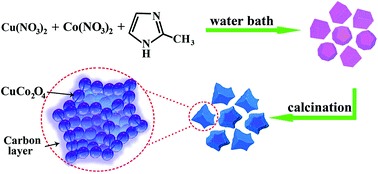Porous carbon-coated CuCo2O4 concave polyhedrons derived from metal–organic frameworks as anodes for lithium-ion batteries†
Abstract
Porous carbon-coated CuCo2O4 concave polyhedra were successfully prepared with the assistance of a metal–organic framework (MOF). In this work, the MOF not only played a role as a template to form the polyhedra, but also provided a carbon matrix to coat CuCo2O4 under the high temperature pyrolysis of a zeolitic imidazolate framework (ZIF) (one kind of MOF). The porous carbon-coated CuCo2O4 concave polyhedra delivered a superior capacity. This good property can be attributed to the following reasons. Firstly, a good framework was provided by the MOF to form the porous polyhedron structures, which showed a large specific surface area, enhancing the contact between the electrode and electrolyte. Secondly, the carbon layer coated on the CuCo2O4 concave polyhedra could accommodate the volume change during the process of lithiation–delithiation and further enhance the conductivity of the electrode. The synthesis process of porous CuCo2O4 concave polyhedra proves that the approach has a promising application for the anode materials of lithium-ion batteries (LIBs), catalysis, energy fields, etc.


 Please wait while we load your content...
Please wait while we load your content...